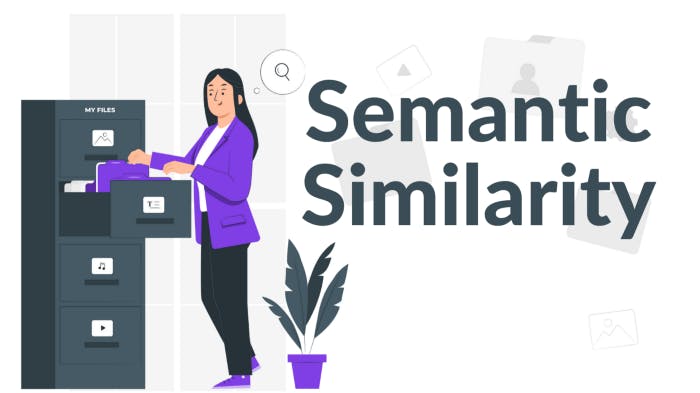Semantic Similarity
 Semantic similarity is an important aspect of Natural Language Processing and one of the fundamental problems for many NLP applications and related disciplines. Semantic Textual Similarity can be described as a measure used to a set of documents with the goal of determining their semantic similarity.
Semantic similarity is an important aspect of Natural Language Processing and one of the fundamental problems for many NLP applications and related disciplines. Semantic Textual Similarity can be described as a measure used to a set of documents with the goal of determining their semantic similarity.
The similarities between the documents are based on their direct and indirect linkages. The existence of semantic relations among them can be used to measure and recognize these linkages.
Many semantic web applications, such as community extraction, ontology building, and entity identification, benefit from semantic similarity. It is also beneficial for Twitter searches, where the ability to reliably quantify semantic relatedness between concepts or entities is necessary.
One of the primary difficulties in information retrieval is retrieving a set of documents and finding images by captions that are semantically connected to a particular user query in a web search.
Benefits of Semantic Similarity
- Use semantic similarity to create biomedical ontologies, such as gene ontologies. Examine documents related to your research and compare genes used in other bio-entries.
- It is also used to compare the similarity of geographical feature type ontologies.
- Sentiment analysis, natural language understanding, and machine translation can all benefit from semantic similarity, either directly or indirectly.
- Using Semantic analysis, you can quickly identify similar company or product names. Examine the similarities between the products and services offered in the industry by analyzing competitive product features.
- Detect duplicate documents with ease, reduce labor, and increase efficiency. With semantic analysis, you can detect plagiarism even when the sentences/words are moved and modified.
Tools to Use for Semantic Similarity
1. BytesView
Bytesview’s advanced semantic similarity solution can analyze large volumes of text data to detect similar sentence structures. Using their text analysis solutions, you can easily collect text data from multiple sources and use it to focus on improving your customer support services, employee and customer response solutions, and so on.
2. Rosette
Rosette’s text analysis API can perform semantic analysis as well as finer-grained analysis on social media data. Customers’ emotions, for example, when they mention a particular product, company, or person. If you have global data, you can train Rosette’s sentiment analysis tool to recognize up to 30 languages.
3.Monkeylearn
MonkeyLearn is a text analysis program known for its adaptability. Simply create tags and then manually highlight different parts of the text to show which content belongs to which tag. Over time, the software learns on its own and can process multiple files at the same time It contains a collection of pre-trained models for tasks such as sentiment analysis, keyword extraction, urgency detection, and much more
4. Natural Language API for Google Cloud
Using Google’s machine learning, the Google Cloud Natural Language API helps businesses understand and help advance information in the text. It essentially offers two types of options: a set of pre-trained models for analyzing sentiment, locating entities, and categorizing content, and Cloud Auto ML, a suite for creating custom machine learning models. Creating your own models is straightforward, and there are numerous guides available to help you navigate the API.
5. Twinworld
Twinworld API is another great tool to use for semantic similarity analysis. It claims to have the best sentiment analysis technology available, allowing it to distinguish between sarcasm and other ambiguous derogatory mentions.
As it can tell you exactly that people perceive your company’s social media accounts, this tool is best used in conjunction with your social channels.
I hope you find this article useful😀